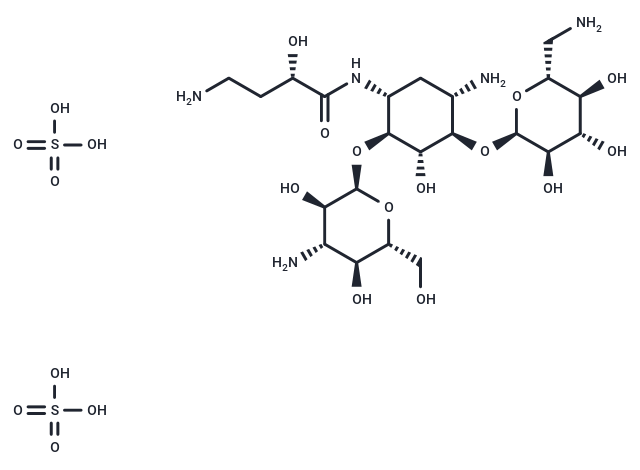Shopping Cart
Remove All Your shopping cart is currently empty
Your shopping cart is currently empty
Amikacin disulfate (BAY-416651 sulfate) is a semi-synthetic aminoglycoside antibiotic derived from kanamycin A.

| Pack Size | Price | USA Warehouse | Global Warehouse | Quantity |
|---|---|---|---|---|
| 500 mg | $42 | - | In Stock | |
| 1 g | $64 | - | In Stock |
| Description | Amikacin disulfate (BAY-416651 sulfate) is a semi-synthetic aminoglycoside antibiotic derived from kanamycin A. |
| In vitro | Amikacin sulfate has high affinities for 16S rRNA of the bacterial 30S ribosome, causing misreading of mRNA and leaving the bacterium unable to synthesize proteins vital to its growth. [1] Amikacin is active in vitro against Pseudomonas species, [2] Escherichia coli[3], Proteus species (indole-positive and indole-negative), Providencia species, Klebsiella-Enterobacter-Serratia species, Acinetobacter (formerly Mima-Herellea) species, and Citrobacter freundii.[4] [5] In vitro studies have shown that amikacin sulfate combined with a beta-lactam antibiotic acts synergistically against many clinically significant Gram-negative organisms. In vitro studies have shown that amikacin sulfate combined with beta-lactam antimicrobial agents including moxalactam or piperacillin acts synergistically against many clinically significant Gram-negative organisms. [6] |
| In vivo | Amikacin (80 mg/kg i.v.) significantly reduced pseudomonal densities within aortic vegetations compared to controls in the experimental rabbit endocarditis model. In addition, amikacin given once daily is still more effective than the twice-daily regimen. [7] Amikacin given alone at a dose of 50 mg/kg, in one, two, or three divided doses, showed remarkable activity in model of Mycobacterium avium complex infections in beige mice. Addition of clofazimine increased the activity significantly. [8] |
| Synonyms | Pierami, BB-K8, BAY-416651 sulfate, Amikacin sulfate |
| Molecular Weight | 781.76 |
| Formula | C22H43N5O13·2H2O4S |
| Cas No. | 39831-55-5 |
| Smiles | O=S(O)(O)=O.NCC[C@H](O)C(N[C@H](C[C@@H]([C@H]([C@@H]1O)O[C@H]2O[C@@H]([C@H]([C@@H]([C@H]2O)O)O)CN)N)[C@@H]1O[C@H]3O[C@@H]([C@H]([C@@H]([C@H]3O)N)O)CO)=O.O=S(O)(O)=O |
| Relative Density. | no data available |
| Color | White |
| Appearance | Solid |
| Storage | Powder: -20°C for 3 years | In solvent: -80°C for 1 year | Shipping with blue ice/Shipping at ambient temperature. | |||||||||||||||||||||||||||||||||||
| Solubility Information | H2O: 100 mg/mL (127.92 mM), Sonication is recommended. DMSO: Insoluble | |||||||||||||||||||||||||||||||||||
Solution Preparation Table | ||||||||||||||||||||||||||||||||||||
H2O
| ||||||||||||||||||||||||||||||||||||
| Size | Quantity | Unit Price | Amount | Operation |
|---|

Copyright © 2015-2025 TargetMol Chemicals Inc. All Rights Reserved.